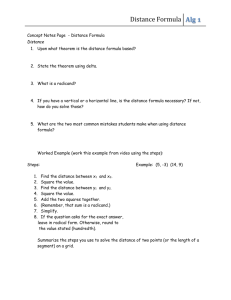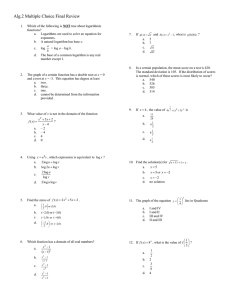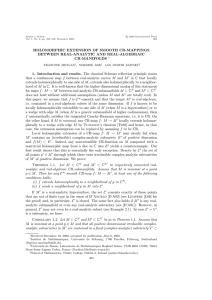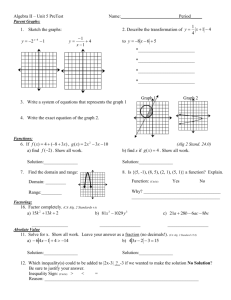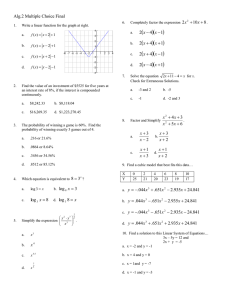POINTS OF SMALL HEIGHT ON VARIETIES DEFINED OVER A FUNCTION FIELD
advertisement
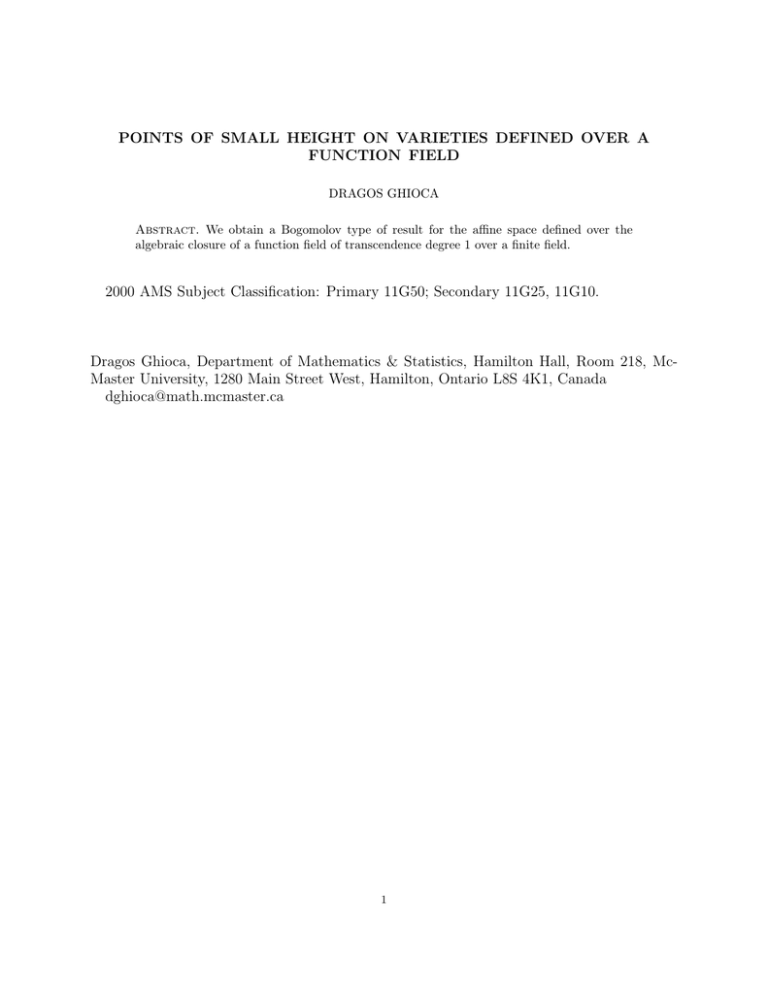
POINTS OF SMALL HEIGHT ON VARIETIES DEFINED OVER A
FUNCTION FIELD
DRAGOS GHIOCA
Abstract. We obtain a Bogomolov type of result for the affine space defined over the
algebraic closure of a function field of transcendence degree 1 over a finite field.
2000 AMS Subject Classification: Primary 11G50; Secondary 11G25, 11G10.
Dragos Ghioca, Department of Mathematics & Statistics, Hamilton Hall, Room 218, McMaster University, 1280 Main Street West, Hamilton, Ontario L8S 4K1, Canada
dghioca@math.mcmaster.ca
1
1. Introduction
The Manin-Mumford conjecture, proved by Raynaud [8], asserts that if an irreducible
subvariety X of an abelian variety A defined over a number field contains a Zariski dense
subset of torsion points of A, then X is a translate of an algebraic subgroup of A by a
torsion point. We describe next the Bogomolov conjecture, which is a generalization of the
Manin-Mumford conjecture.
Let A be an abelian variety defined over a number field K. We fix an algebraic closure
K alg for K and we let b
h : A(K alg ) → R≥0 be the Néron height associated to a symmetric,
ample line bundle on A. Let X be an irreducible subvariety of A. For each n ≥ 1, we let
1
alg
(1)
Xn = x ∈ X(K ) | b
h(x) <
.
n
The Bogomolov conjecture, which was proved in a special case by Ullmo [10] and in the
general case by Zhang [12], asserts that if for every n ≥ 1, Xn is Zariski dense in X, then X
is the translate of an abelian subvariety of A by a torsion point of A. Both Ullmo and Zhang
proved the Bogomolov conjecture via an equidistribution statement for points of small height
on A. The characteristic 0 function field case of the Bogomolov conjecture was proved by
Moriwaki [7], while a generalization of the Bogomolov statement to semi-abelian varieties
was obtained by David and Philippon in [5].
The case of Bogomolov conjecture for any power Gnm of the multiplicative group was first
proved by Zhang in [11]. Other proofs of the Bogomolov conjecture for Gnm were given by
Bilu [1] and Bombieri and Zannier [2]. This last paper constituted our inspiration for proving
here a version of the Bogomolov conjecture for the affine scheme defined over the algebraic
closure of a function field of transcendence degree 1 over a finite field (see our Theorem 2.2).
The picture in positive characteristic for the Bogomolov conjecture is much different due
to the varieties defined over finite fields. Indeed, if A is a semi-abelian variety defined over
a finite field Fq , then every subvariety X of A defined over a finite field contains a Zariski
alg
dense subset of torsion points (because X(Falg
q ) ⊂ A(Fq ) = Ator is Zariski dense in X).
Because all torsion points have canonical height 0, then each subvariety X defined over
Falg
q constitutes a counterexample to the obvious translation in positive characteristic of the
classical Bogomolov statement. Thus, it is not true in characteristic p that only translates of
algebraic tori are accumulating subvarieties of Gnm for points of small height. All subvarieties
of Gnm invariant under a power of the Frobenius are accumulating varieties for points of small
height. The group structure of the ambient space Gnm disappears from the conclusion of a
Bogomolov statement for Gnm . This motivated our approach to Theorem 2.2 in which the
ambient space is simply the affine space, and not an algebraic torus as in [2].
We note that Bosser [3] proved a Bogomolov statement for the additive group scheme in
characteristic p under the action of a Drinfeld module of generic characteristic. His result
is not yet published, but the main ingredient of his proof was published in [4]. The author
formulated in [6] an equidistribution statement for points of small height for Drinfeld modules
of generic characteristic (and we also proved in [6] a first instance of our equidistribution
statement). Our equidistribution statement is similar with the ones proved by Ullmo [10] and
Zhang [12] for abelian varieties. Finally, we note that our Theorem 2.2 can be interpreted
as a Bogomolov type statement for Drinfeld modules defined over finite fields.
I would like to thank both referees for their very helpful suggestions.
2
2. Statement of our main result
In this section we state our main result Theorem 2.2, which we prove in Section 3.
For each finite extension K of Fp (t), we construct the usual set of valuations MK and
the associated local heights hv on K. For the reader’s convenience we sketch this classical
construction (for more details, see Chapter 2 in [9]). Let R := Fp [t]. Foreach irreducible
1
polynomial P ∈ R we let vP be the valuation on Fp (t) given by vP Q
= ordP (Q1 ) −
Q2
ordP (Q2 ) for every nonzero Q1 , Q2 ∈ R, where ordP (Qi ) is theorder
of the polynomial Qi at
Q1
P . Also, we construct the valuation v∞ on Fp (t) given by v∞ Q2 = deg(Q2 ) − deg(Q1 ) for
every nonzero Q1 , Q2 ∈ R. We let the degree of vP be d(vP ) = deg(P ) for every irreducible
polynomial P ∈ R
Pand we also let d(v∞ ) = 1. Then, for every nonzero x ∈ Fp (t), we have
the sum formula v∈MF (t) d(v) · v(x) = 0.
p
Let K be a finite extension of Fp (t). We normalize each valuation w from MK so that
the range of w is the entire Z. For w ∈ MK , if v ∈ MFp (t) lies below w, then e(w|v)
represents the corresponding ramification index, while f (w|v) represents the relative residue
(w|v)d(v)
degree. Also, we define d(w) = f[K:F
. Let x ∈ K. We define the local height of
p (t)]
x at w P
as hw (x) = −d(w) min{w(x), 0}. Finally, we define the (global) height of x as
h(x) = w∈MK hw (x).
We extend the above heights to every affine space An defined over Fp (t)alg . Let K be a
finite extension of Fp (t) and let P = (x1 , . . . , xn ) ∈ AnK . We define the local height of P
at w as P
hw (P ) = hw (x1 , . . . , xn ) = maxni=1 hw (xi ). We define the (global) height of P as
h(P ) = w∈MK hw (P ).
The following proposition contains standard results on the Weil height h.
Proposition 2.1. For every P, Q ∈ AnFp (t)alg , the following statements are true:
(i) h(P ) = 0 if and only if P ∈ AnFalg .
p
(ii) h(P + Q) ≤ h(P ) + h(Q) (triangle inequality). Moreover, if x1 , x2 ∈ Fp (t)alg , then
h(x1 + x2 ) ≤ h(x1 , x2 ).
Proof. The results of Proposition 2.1 are classical, possibly with the exception of the ”moreover” part of (ii). Hence we show next how to obtain that statement. For each place v,
v(x1 + x2 ) ≥ min{v(x1 ), v(x2 )}. Thus hv (x1 + x2 ) ≤ max{hv (x1 ), hv (x2 )} = hv (x1 , x2 ).
Therefore h(x1 + x2 ) ≤ h(x1 , x2 ).
The following theorem is our main result.
Theorem 2.2. Let X be an affine subvariety of An defined over Fp (t)alg . Let Y be the
alg
Zariski closure of the set X(Falg
p ), i.e. Y is the largest Fp -subvariety of X.
There exists a positive constant C, depending only on X, such that if P ∈ X(Fp (t)alg ) and
h(P ) < C, then P ∈ Y (Fp (t)alg ).
Remark 2.3. The result of Theorem 2.2 extends to any closed projective subvariety X of a
projective space Pn . Indeed, we cover Pn by finitely many open affine spaces {Ui }i , and then
apply Theorem 2.2 to each X ∩ Ui (which is a closed subvariety of the affine space Ui ).
3
3. Proof of our main result
Unless otherwise stated, all our subvarieties are closed. We start with a definition.
Definition 3.1. We call reduced a non-constant polynomial f ∈ Fp [t][X1 , . . . , Xn ], whose
coefficients ai have no non-constant common divisor in Fp [t]. For each finite extension K
of Fp (t), we define the local height hwP
(f ) of f at a place w ∈ MK as maxi hw (ai ). Then we
define the (global) height h(f ) of f as w∈MK hw (f ). Note that our definition is independent
of K, as h(f ) equals the maximum of the degrees of the coefficients ai ∈ Fp [t] of f .
Our proof of Theorem 2.2 goes through a series of lemmas.
Lemma 3.2. Let f ∈ Fp [t][X1 , . . . , Xn ] be a reduced polynomial of total degree d. For every
k such that pk ≥ 2 h(f ), if (x1 , . . . , xn ) ∈ AnFp (t)alg satisfies f (x1 , . . . , xn ) = 0, then either
h(x1 , . . . , xn ) ≥
1
2d
or
k
k
f (xp1 , . . . , xpn ) = 0.
Proof. Let k satisfy the inequality P
from the statement of Lemma 3.2. Let (x1 , . . . , xn ) ∈
n
AFp (t)alg be a zero of f . We let f = i ai Mi , where the ai ’s are the nonzero coefficients of f
and the Mi ’s are the corresponding monomials of f . For each i, we let mi := Mi (x1 , . . . , xn ).
k
k
Assume f (xp1 , . . . , xpn ) 6= 0.
k
k
We let K = Fp (t)(x1 , . . . , xn ). If ζ = f (xp1 , . . . , xpn ), then (because ζ 6= 0)
X
(2)
d(w)w(ζ) = 0.
w∈MK
k
Because f (x1 , . . . , xn ) = 0, we get ζ = ζ − f (x1 , . . . , xn )p and so,
X
k
k
(3)
ζ=
(ai − api )mpi .
i
k
Claim 3.3. For every g ∈ Fp [t], tp
k
− t | gp − g .
P
k
k
Then g p = m
b tjp . The proof of Claim 3.3 is
j=0
j
k
k
immediate because for every j ∈ N, tp − t | tjp − tj .
Proof of Claim 3.3. Let g :=
Pm
j
jt .
j=0 b
Using the result of Claim 3.3 and equation (3), we get
X
k
k
(4)
ζ = (tp − t)
bi mpi ,
i
where bi =
ai −api
pk
t
k
−t
∈ Fp [t]. Let S be the set of valuations w ∈ MK such that w lies above an
k
irreducible factor (in Fp [t]) of tp − t. For each w ∈ S,
(5)
k
d(w) · w(ζ) ≥ d(w) · w(tp − t) − dpk hw (x1 , . . . , xn ),
4
because for each i, w(bi ) ≥ 0 (as bi ∈ Fp [t] and w does not lie over v∞ ) and also,
k
d(w) · w(mpi ) ≥ −dpk hw (x1 , . . . , xn ),
as the total degree of Mi is at most d.
P
k
For each w ∈ MK \ S, because ζ = i ai mpi ,
d(w) · w(ζ) ≥ − hw (f ) − dpk hw (x1 , . . . , xn ).
(6)
Adding all inequalities from (5) and (6) we obtain
X
(7) 0 =
d(w) · w(ζ) ≥ − h(f ) − dpk h(x1 , . . . , xn ) +
w∈MK
X
k
d(w) · w(tp − t).
w∈MK
k
w(tp −t)>0
By the coherence of the valuations on Fp (t)alg ,
X
X
k
k
k
d(w) · w(tp − t) =
d(v) · v(tp − t) = −v∞ (tp − t) = pk .
w∈MK
k
w(tp −t)>0
v∈MFp (t)
k
v(tp −t)>0
Thus, inequality (7) yields
0 ≥ − h(f ) − dpk h(x1 , . . . , xn ) + pk
and so,
(8)
h(x1 , . . . , xn ) ≥
1 h(f )
−
.
d
dpk
Because k was chosen such that pk ≥ 2 h(f ), we conclude
(9)
h(x1 , . . . , xn ) ≥
1
.
2d
Lemma 3.4. Let k be a positive integer. Let K be a finite field extension of Fp (t) and let
k
k
f ∈ K[X1 , . . . , Xn ] be an irreducible polynomial. If f (X1 , . . . , Xn ) | f (X1p , . . . , Xnp ), then
there exists a ∈ K \ {0} such that af ∈ Fpk [X1 , . . . , Xn ].
Proof. Let Z be the zero set for f . Let F be the Frobenius on Fp . The hypothesis on f shows
that for every P ∈ Z(K alg ), F k P ∈ Z(K alg ). Hence F k Z ⊂ Z. Because Z is irreducible (as
f is irreducible) and dim(F k Z) = dim(Z), we conclude F k Z = Z. Therefore Z is defined
over the fixed field Fpk of F k . Moreover, Z is defined over Fpk ∩ K. Thus there exists a
polynomial g ∈ Fpk [X1 , . . . , Xn ] such that g = a · f , for some nonzero a ∈ K.
Lemma 3.5. Let X ⊂ An be an affine variety of dimension less than n defined over Fp (t)alg .
There exists a positive constant C, depending only on X, and there exists an affine Falg
p variety Z ⊂ An of dimension less than n, which also depends only on X, such that for every
P ∈ X(Fp (t)alg ), either P ∈ Z(Fp (t)alg ) or h(P ) ≥ C.
Remark 3.6. The only difference between Lemma 3.5 and Theorem 2.2 is that we do not
require Z be contained in X.
5
Proof of Lemma 3.5. Let K be the smallest field extension of Fp (t) such that X is defined
over K. Let pm be the inseparable degree of the extension K/Fp (t) (m ≥ 0). Let
[
X1 =
Xσ,
σ
m
where σ denotes any field morphism K → Fp (t)alg over Fp (t). The variety X1 is an Fp (t)1/p variety. Also, X1 depends only on X. Thus, if we prove Lemma 3.5 for X1 , then our result
m
will hold also for X ⊂ X1 . Hence we may and do assume that X is defined over Fp (t)1/p .
We let F be the Frobenius on Fp . The variety X 0 = F m X is an Fp (t)-variety, which depends
only on X. Assume we proved Lemma 3.5 for X 0 and let C 0 and Z 0 be the positive constant
0
and the Falg
p -variety, respectively, associated to X , as in the conclusion of Lemma 3.5. Let
P ∈ X(Fp (t)alg ). Then P 0 := F m (P ) ∈ X 0 (Fp (t)alg ). Thus, either
h(P 0 ) ≥ C 0 or
P 0 ∈ Z 0 (Fp (t)alg ).
In the former case, because h(P ) = p1m h(P 0 ), we obtain a lower bound for the height of
P , depending only on X (note that m depends only on X). In the latter case, if we let
n
m
Z be the Falg
p -subvariety of A , obtained by extracting the p -roots of the coefficients of
alg
a set of polynomials (defined over Fp ) which generate the vanishing ideal for Z 0 , we get
P ∈ Z(Fp (t)alg ). By its construction, Z depends only on X and so, we obtain the conclusion
of Lemma 3.5.
Thus, from now on in this proof, we assume X is an Fp (t)-variety. We proceed by induction
on n.
The case n = 1 is obvious, because any subvariety of A1 , different from A1 , is a finite
union of points. Thus we may take Z = X(Falg
p ), (which is also a finite union of points)
and C := minP ∈(X\Z)(Fp (t)alg ) h(P ). By construction, C > 0 (there are finitely many points
in (X \ Z) (Fp (t)alg ) and they all have positive height by Proposition 2.1 (i)). If there are
no points in X(Fp (t)alg ) \ X(Falg
p ), then we may take C = 1, say.
Remark 3.7. The above argument proves the case n = 1 for Theorem 2.2, because the variety
Z that we chose is a subvariety of X.
We assume Lemma 3.5 holds for n − 1 and we prove it for n (n ≥ 2). We fix a set of
defining polynomials for X which contains polynomials Pi ∈ Fp [t][X1 , . . . , Xn ] for which
max deg(Pi )
i
is minimum among all possible sets of defining polynomials for X (where deg Pi is the total
degree of Pi ). We may assume all of the polynomials we chose are reduced. If all of them
have coefficients from a finite field, i.e. Fp , then Lemma 3.5 holds with Z = X and C any
positive constant.
Assume there exists a reduced polynomial f ∈
/ Fp [X1 , . . . , Xn ] in the fixed set of defining
equations for X. Let {fi }i be the set of all the Fp (t)-irreducible factors of f . For each i let
Hi be the zero set of fi . Then X is contained in the finite union ∪i Hi . The polynomials fi
depend only on f . Thus it suffices to prove Lemma 3.5 for each Hi . Hence we may and do
assume X is the zero set of a reduced Fp (t)-irreducible polynomial f ∈
/ Fp [X1 , . . . , Xn ].
6
Let P = (x1 , . . . , xn ) ∈ X(Fp (t)alg ). We apply Lemma 3.2 to f and P and conclude that
either
1
(10)
h(P ) ≥
2 deg(f )
or there exists k depending only on h(f ) such that
(11)
k
k
f (xp1 , . . . , xpn ) = 0.
If (10) holds, then we obtained a good lower bound for the height of P (depending only on
the degree of f ).
Assume (11) holds. Because f is an irreducible and reduced polynomial, whose coefficients
k
k
are not all in Fp , Lemma 3.4 yields that f (X1 , . . . , Xn ) cannot divide f (X1p , . . . , Xnp ). We
know f has more than one monomial because it is reduced and not all of its coefficients are
in Fp . Without loss of generality, we may assume f has positive degree in Xn . Because f
k
k
is irreducible, the resultant R of the polynomials f (X1 , . . . , Xn ) and f (X1p , . . . , Xnp ) with
respect to the variable Xn is nonzero. Moreover, R depends only on f (we recall that k
depends only on h(f )).
The nonzero polynomial R ∈ Fp (t)[X1 , . . . , Xn−1 ] vanishes on (x1 , . . . , xn−1 ). Applying
the induction hypothesis to the hypersurface R = 0 in An−1 , we conclude there exists an
n−1
, depending only on R (and so, only on X) and
Falg
p -variety Z, strictly contained in A
there exists a positive constant C, depending only on R (and so, only on X) such that either
(12)
h(x1 , . . . , xn−1 ) ≥ C or
(13)
(x1 , . . . , xn−1 ) ∈ Z(Fp (t)alg ).
If (12) holds, then h(x1 , . . . , xn−1 , xn ) ≥ h(x1 , . . . , xn−1 ) ≥ C and we have a height inequality
as in the conclusion of Lemma 3.5. If (13) holds, then (x1 , . . . , xn ) ∈ (Z × A1 ) (Fp (t)alg ) and
n
Z × A1 is an Falg
p -variety, strictly contained in A , as desired in Lemma 3.5. This proves the
inductive step and concludes the proof of Lemma 3.5.
The following result is an immediate corollary of Lemma 3.5.
Corollary 3.8. Let X be a proper subvariety of An defined over Fp (t)alg . There exists a
positive constant C and a proper subvariety Z ⊂ An defined over Falg
p , such that the pair
(C, Z) satisfies the conclusion of Lemma 3.5, and moreover Z is minimal with this property
(with respect to the inclusion of subvarieties of An ).
Proof. Let (C1 , Z1 ) and (C2 , Z2 ) be two pairs of a positive constant and a proper subvariety
of An defined over Falg
p , such that both pairs satisfy the conclusion of Lemma 3.5. Clearly,
(min{C1 , C2 }, Z1 ∩ Z2 ) also satisfies the conclusion of Lemma 3.5. Using the fact that there
exists no infinite descending chain (with respect to the inclusion) of subvarieties of An , we
obtain the conclusion of Corollary 3.8.
We are ready now to prove Theorem 2.2.
Proof of Theorem 2.2. If X = An , the conclusion is immediate. Therefore, assume from now
on in this proof that X is strictly contained in An .
We prove Theorem 2.2 by induction on n. The case n = 1 was already proved during the
proof of Lemma 3.5 (see Remark 3.7).
7
We assume Theorem 2.2 holds for n − 1 and we will prove that it also holds for n (n ≥ 2).
Let C and Z be as in the conclusion of Corollary 3.8 for X. Also, we recall that Y , as
defined in the statement of Theorem 2.2, is the largest Falg
p -subvariety of X. Our goal is to
show that Z ⊂ X, because this would mean that Z ⊂ Y , as Y is the largest subvariety of X
defined over Falg
p .
Assume Z is not a subvariety of X. Thus there exists an Falg
p -irreducible subvariety W of
alg
Z, such that W ∩ X is a finite union of proper Fp (t) -irreducible subvarieties {Wj }lj=1 of
W . Let j ∈ {1, . . . , l}. Note that both W and Wj depend only on X (because Z and W ∩ X
have finitely many geometrically irreducible components).
Assume P := (x1 , . . . , xn ) ∈ Wj (Fp (t)alg ). According to Lemma 3.5, dim Z < n and so,
dim W =: d < n. Moreover, dim Wj < dim W , because both W and Wj are irreducible and
Wj is a proper subvariety of W . Without loss of generality, we may assume the projection
π : An → Ad , when restricted to W is generically finite-to-one (after relabelling the n
coordinates of An we can achieve this anyway).
Let Uj be the Zariski closure of π(Wj ). Because Wj is a closed subvariety of W of smaller
dimension, dim Uj < d. Because Wj depends only on X, Uj depends only on X. Because
d < n and Uj is a subvariety strictly contained in Ad , we may apply the inductive hypothesis
to Uj . Let Uj,0 be the largest Falg
p -subvariety of Uj . We conclude there exists a positive
constant Cj depending only on the variety Uj (and so, depending only on the variety X)
such that either
(14)
h(x1 , . . . , xd ) ≥ Cj
or
(15)
(x1 , . . . , xd ) ∈ Uj,0 (Fp (t)alg ).
If (14) holds,
xn ) ≥ h(x1 , . . . , xd ) ≥ Cj . If (15) holds, then (x1 , . . . , xn ) ∈
thenalgh(x1 , . . . ,alg
n−d
(Fp (t) ). The Fp -variety Uj,0 × An−d intersects W in a subvariety of smaller
Uj,0 × A
dimension because
dim(π(Uj,0 × An−d )) = dim(Uj,0 ) < d = dim(π(W )).
Let Vj := Uj,0 × An−d ∩ W . Then P lies on Vj , and Vj is an Falg
p -variety (both Uj,0 and
alg
W are Fp -varieties) which is properly contained in W . Moreover, Vj depends only on X,
because both W and Uj,0 × An−d depend only on X.
Hence, for each P ∈ W ∩ X, there exists j ∈ {1, . . . , l} such that P ∈ Wj (Fp (t)alg ). Then
(16)
either h(P ) ≥ Cj ,
(17)
or P ∈ Vj (Fp (t)alg ).
Let C 0 := min{C, C1 , . . . , Cl }. Then C 0 is a positive constant which depends only on X.
Let Z 0 beSthe proper subvariety of Z obtained by replacing the irreducible component W
of Z by li=1 Vi . Then Z 0 is also a closed subvariety of An defined over Falg
p . Moreover,
because the pair (C, Z) satisfies Lemma 3.5, using also (16) and (17), we conclude that the
pair (C 0 , Z 0 ) also satisfies the conclusion of Lemma 3.5. This contradicts the minimality of
Z which satisfies the conclusion of Corollary 3.8. This contradiction shows that Z ⊂ X (and
so, Z ⊂ Y ), which concludes the proof of Theorem 2.2.
8
References
[1] Y. Bilu, Limit distribution of small points on algebraic tori. Duke Math. J. 89 (1997), no. 3, 465-476.
[2] E. Bombieri and U. Zannier, Algebraic points on subvarieties of Gnm . Internat. Math. Res. Notices 7
(1995), 333-347.
[3] V. Bosser, Transcendance et approximation diophantienne sur les modules de Drinfeld. Thése de
l’Université Paris 6, 23/03/2000.
[4] V. Bosser, Hauteurs normalisées des sous-variétés de produits de modules de Drinfeld. (French) [Normalized heights of the subvarieties of products of Drinfeld modules] Compositio Math. 133 (2002), no. 3,
323-353.
[5] S. David and P. Philippon, Sous-variétés de torsion des variétés semi-abéliennes. (French) [Torsion subvarieties of semi-abelian varieties] C. R. Acad. Sci. Paris Sr. I Math. 331 (2000), no. 8, 587-592.
[6] D. Ghioca, Equidistribution for torsion points of a Drinfeld module. to appear in Mathematische Annalen,
2006.
[7] A. Moriwaki, Arithmetic height functions on finitely generated fields. Invent. Math 140 (2000), no. 1,
101-142.
[8] M. Raynaud, Sous-variétés d’une variété abélienne et points de torsion. (French) [Subvarieties of an
abelian variety and torsion points]. Arithmetic and Geometry, Vol. I, 327-352, Prog. Math., 35,
Birkhauser boston, Boston, MA, 1983.
[9] J.-P. Serre, Lectures on the Mordell-Weil theorem. Translated from the French and edited by Martin
Brown from notes by Michel Waldschmidt. With a foreword by Brown and Serre. Third edition. Aspects
of Mathematics. Friedr. Vieweg & Sohn, Braunschweig, 1997. x+218 pp.
[10] E. Ullmo, Positivité et discrétion des points algébriques des courbes. (French) [Positivity and discreteness
of algebraic points of curves] Ann. of Math. (2) 147 (1998), no. 1, 167-179.
[11] S. Zhang, Positive line bundles on arithmetic varieties. J. Amer. Math. Soc. 8 (1995), no. 1, 187-221.
[12] S. Zhang, Equidistribution of small points on abelian varieties. Ann. of Math. (2) 147 (1998), no. 1,
159-165.
Dragos Ghioca, Department of Mathematics & Statistics, Hamilton Hall, Room 218, McMaster University, 1280 Main Street West, Hamilton, Ontario L8S 4K1, Canada
E-mail address: dghioca@math.mcmaster.ca
9
